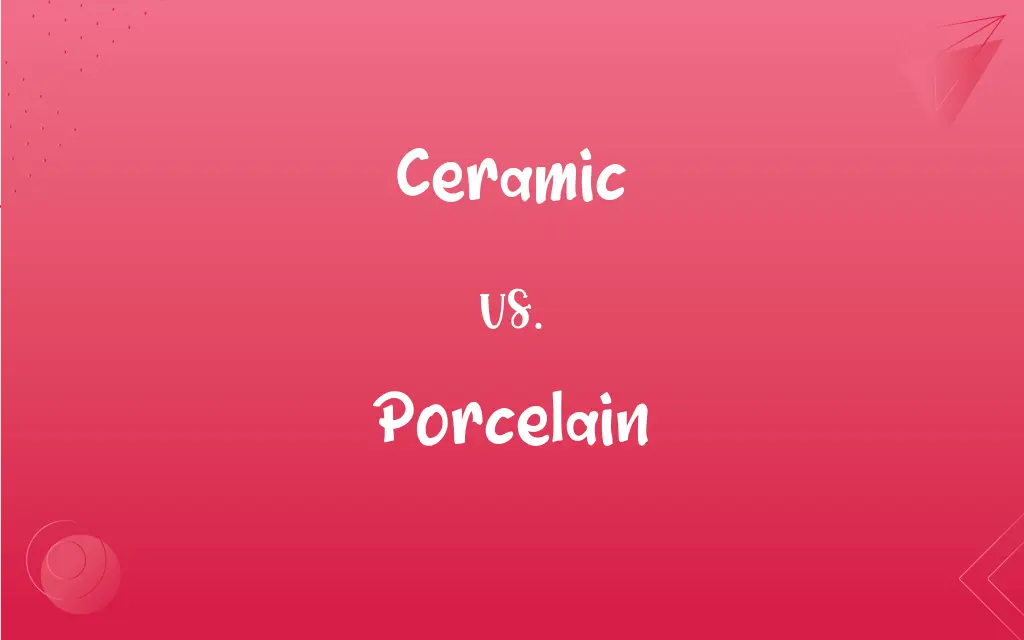Ceramic vs. Porcelain: What's the Difference?
Edited by Janet White || By Harlon Moss || Updated on June 5, 2024
Ceramic is a general term for hard, brittle materials made from heated clay, while porcelain is a specific, high-quality type of ceramic that's fine-grained and translucent.

Key Differences
Ceramic is a broad category of materials that encompasses various types of clay products which, when exposed to high heat, become hardened. On the other hand, porcelain is a particular kind of ceramic, known for its refined nature, resulting from a specific clay mixture and higher firing temperatures.
In terms of composition, ceramics can be made from various clay types, sometimes mixed with other natural materials. Porcelain, however, is typically made using kaolin clay, combined with feldspar, ball clay, bone ash, and other materials, which give it a whiter and more translucent appearance.
Durability is another distinguishing factor between ceramic and porcelain. While both materials are durable, porcelain's dense nature, resulting from its fine-grained structure and high firing temperature, often makes it more robust and less porous than other ceramics. This property often makes porcelain a preferred choice for high-traffic areas or situations requiring a high degree of water resistance.
Aesthetically, ceramic offers a wide range of appearances, given its diverse compositions and potential glazes. Porcelain, with its fine texture, can achieve a polished and sophisticated look, making it highly valued for delicate and ornate pieces, from fine china to decorative vases.
In terms of applications, while ceramics are found in various household and architectural products, porcelain's distinct properties make it particularly suited for specific uses like dental veneers, electrical insulators, and fine dinnerware.
ADVERTISEMENT
Comparison Chart
Base Material
Various clay types
Typically kaolin clay
Translucency
Generally opaque
Translucent
Durability
Durable
More durable and less porous due to higher firing temperatures
Appearance
Diverse range
Fine-grained, polished and sophisticated
Typical Uses
Household items, architectural products
Fine china, dental veneers, electrical insulators
ADVERTISEMENT
Ceramic and Porcelain Definitions
Ceramic
A broad category of clay-based materials.
The ceramic industry has evolved with technological advancements, producing stronger and more decorative items.
Porcelain
A translucent ceramic known for its white and polished appearance.
The porcelain figurine on the mantel was an heirloom from her grandmother.
Ceramic
Hardened material formed by the heat treatment of clay.
Ceramic tiles are a popular choice for kitchen backsplashes.
Porcelain
Durable ceramic material fired at high temperatures.
Porcelain tiles are ideal for bathrooms due to their low water absorption rate.
Ceramic
Non-metallic, inorganic substance subjected to high temperatures.
Ceramic pots retain heat well, making them excellent for slow-cooked dishes.
Porcelain
A type of ceramic valued for its beauty and strength.
Antique porcelain collectibles can fetch high prices at auctions.
Ceramic
A product often glazed and fired to produce a smooth surface.
The ceramic vase she bought was beautifully hand-painted.
Porcelain
Ceramic made using kaolin, feldspar, and other specific materials.
Porcelain teacups have a refined elegance that's hard to match.
Ceramic
Items made from clay and then baked at high temperatures.
Ceramic art has been practiced for thousands of years across cultures.
Porcelain
A high-quality, fine-grained ceramic made from kaolin clay.
Porcelain dishes are often reserved for special occasions because of their delicate nature.
Ceramic
Any of various hard, brittle, heat-resistant and corrosion-resistant materials made by shaping and then firing a nonmetallic mineral, such as clay, at a high temperature.
Porcelain
A hard, white, translucent ceramic made by firing a pure clay and then glazing it with variously colored fusible materials; china.
Ceramic
An object, such as earthenware, porcelain, or tile, made of ceramic.
Porcelain
An object made of this substance.
FAQs
What is ceramic?
Ceramic is a material made by heating natural clay, sometimes with other natural materials, to high temperatures.
Are all ceramics waterproof?
While many ceramics are water-resistant, they aren't necessarily waterproof. Some may require a glaze to be fully impermeable.
Where does the word 'ceramic' come from?
The word 'ceramic' comes from the Greek word "keramikos", meaning "pottery."
Are ceramics durable?
Yes, most ceramics are hard, brittle, and resistant to heat and chemical attack, making them durable.
How are ceramic and porcelain cleaned?
Both can generally be cleaned with mild detergents and warm water. It's always best to check manufacturer recommendations.
What are common uses for porcelain?
Porcelain is often used for tableware, decorative objects, and tiles.
ceramic or porcelain?
Generally, porcelain is more durable than other types of ceramics, especially when it comes to wear and chip resistance.
Can both ceramic and porcelain be used outdoors?
Yes, but porcelain is often chosen for outdoor use because of its lower water absorption rate, making it more frost resistant.
What is porcelain?
Porcelain is a specific type of ceramic that is made by heating materials, generally including clay in the form of kaolin, to high temperatures.
How can you tell the difference between ceramic and porcelain?
Porcelain tends to be more translucent and finer-grained than regular ceramic. A "ring" test can sometimes be done; when tapped, porcelain often produces a resonating sound, unlike other ceramics.
Are both ceramic and porcelain used for floor tiles?
Yes, both materials are popular choices for floor tiles, though porcelain is often preferred for high-traffic areas due to its durability.
Do both ceramic and porcelain have cultural significance?
Absolutely. Both have deep historical and cultural roots in many societies, from ancient Chinese porcelain artistry to Native American ceramic pottery.
What are ceramics used for?
Ceramics are used for a wide range of applications, including pottery, tiles, sculptures, and many industrial applications.
Is porcelain always white?
While porcelain is often associated with a white color due to its high kaolin content, it can be tinted or painted with various colors.
Are ceramic and porcelain eco-friendly?
Both can be considered eco-friendly as they're made from natural materials. However, the production process can be energy-intensive.
Can both ceramic and porcelain be repaired if broken?
While minor chips and cracks can sometimes be repaired, it's often challenging to restore them to their original appearance.
Which is heavier, ceramic or porcelain?
The weight can vary based on the specific composition and thickness of the item, but in general, porcelain might be slightly denser and heavier than other ceramics.
Is porcelain more expensive than other ceramics?
Often, yes. Porcelain is typically more expensive due to its quality, craftsmanship, and the materials used.
How is porcelain different from other ceramics?
Porcelain is typically finer, whiter, and more translucent than other ceramics. It's also generally more durable and has a glassier surface.
Is porcelain a type of ceramic?
Yes, porcelain is a specific, high-quality type of ceramic.
About Author
Written by
Harlon MossHarlon is a seasoned quality moderator and accomplished content writer for Difference Wiki. An alumnus of the prestigious University of California, he earned his degree in Computer Science. Leveraging his academic background, Harlon brings a meticulous and informed perspective to his work, ensuring content accuracy and excellence.
Edited by
Janet WhiteJanet White has been an esteemed writer and blogger for Difference Wiki. Holding a Master's degree in Science and Medical Journalism from the prestigious Boston University, she has consistently demonstrated her expertise and passion for her field. When she's not immersed in her work, Janet relishes her time exercising, delving into a good book, and cherishing moments with friends and family.
































































